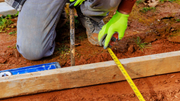
You’ve sketched the outline of your dream pond, stacked the edging stones, and priced out a Poposoap Solar Fountain to keep the surface dancing—but before any of that sparkle can happen you need one invisible hero to fit perfectly: the liner. An undersized or badly-cut membrane means leaks, stress folds, and expensive do-overs. Overshoot the dimensions and you’ll fight with pleats and wasted material. The good news? Measuring for a pond liner is straight math once you know where and how to take each reading. In this guide you’ll learn a proven step-by-step method that contractors rely on, discover why slope and edging style change the numbers, and pick up a few Poposoap tricks that help the liner lie smooth and watertight for years.
Introduction: Why Pond Liner Sizing Matters

A liner isn’t just a sheet of rubber—it’s the watertight foundation of the ecosystem you’re about to build. Size it right and you’ll:
- Prevent leaks & edge pull-downs. Enough overlap anchors the membrane beneath coping stones or planted shelves.
- Reduce maintenance. A liner that hugs contours has fewer folds for sludge to settle in; that keeps Poposoap Pond Filters working at peak efficiency.
- Protect pumps & fish. Tight creases can chafe under stones, and stretched liners thin over time, risking tears that even the best waterfall pump can’t hide.
Tools You’ll Need
- Tape measure (at least twice the pond’s maximum length)
- Long straight pole or PVC pipe for checking depth
- Marker and notebook
- Soft shoes (avoid puncturing soil or underlay)
- Optional: garden hose to trace irregular curves
- Poposoap Waterfall Spillway or Filter Box (handy reference edges when planning overflow)

Measuring Your Pond Dimensions
Step 1 – Capture Length, Width, Depth
- Length (L): Measure the longest straight line across the surface.
- Width (W): Measure the widest point perpendicular to length.
- Depth (D): Place the pole at the deepest spot, from water level to bottom. If shelves differ in depth, record the greatest figure—you can’t cut extra liner after it’s installed.
Tip: For kidney or free-form shapes, take an additional diagonal measurement to confirm you haven’t missed a longer span.
Step 2 – Apply the Liner Formula
Liner Length = L + (2 × D) + 2 ft overlap
Liner Width = W + (2 × D) + 2 ft overlap
The “2 × D” component lets the liner drop to the bottom and rise back up the opposite wall; the extra two feet (about 60 cm) gives you a one-foot safety collar all around for anchoring under coping stones, gravel, or a Poposoap Waterfall Kit spill box.
Examples Using the Formula
Imagine a mid-size wildlife pond that measures 10 ft long, 7 ft wide, and 2 ft deep.
- Liner length: 10 + (2 × 2) + 2 = 16 ft
- Liner width: 7 + (2 × 2) + 2 = 13 ft
Order a sheet at least 16 ft × 13 ft. If your supplier sells in even rolls, round up (e.g., 17 × 14 ft) to allow trimming rather than tugging.
Irregular basins follow the same math—just measure the maximum span of every dimension.
Consider Pond Shape and Edging
- Steep walls vs. gentle slopes: Vertical walls need only the standard formula. If banks slope gradually, add another foot of length and width to account for the extra run.
- Waterfalls & bog shelves: A raised Poposoap Waterfall Kit needs liner to curve up behind the spillway; measure that height and add it to depth before plugging into the equation.
- Rock lips & marsh zones: Thick edging stones can eat an extra 6-8 inches of overlap. Better too much than watching a liner slip under a river-rock border mid-winter thaw.
Poposoap Tips for a Perfect Fit
- Warm before fitting. Leave EPDM or HDPE in the sun for an hour—flexibility means fewer wrinkles.
- Pair with underlayment. A geotextile mat under the liner cushions against stone pressure and roots.
- Solve overflow elegantly. Instead of cutting a risky scupper, seat a Poposoap Waterfall Kit or Filter Box at the pond’s low edge; the liner can fold up inside the housing, directing spill water where you want it.
- Match circulation to volume. Once the liner is filled, power a Poposoap Floating Fountain or Solar Pond Filter sized for the calculated gallons—clear, active water helps the membrane resist UV and bio-film fouling.
Conclusion: Measure Once, Enjoy for Years
Sizing a pond liner accurately isn’t guesswork—it’s a three-measurement equation backed by a conservative overlap rule. Take the time to record the largest length, width, and depth; add the margins; and you’ll never curse a short edge. Combine that snug fit with Poposoap’s solar fountains, waterfall kits, and filter boxes, and your pond will stay tight, bright, and beautifully balanced for seasons to come.
Remember: water will always find the smallest wrinkle or gap. Give your liner the room it needs, anchor it well, and let the rest of the pond’s magic—plants, fish, and the whisper of a Poposoap spillway—unfold on a foundation you trust.







